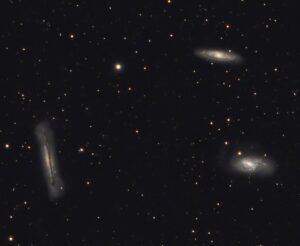Greetings, curious people of the firmament! April welcomes us with a celestial tapestry that promises to captivate all astronomy fans. This month, the stellar stage dresses up with planetary alignments, meteor showers and lunar dances. So adjust your telescope, calibrate your binoculars and prepare for an astronomical odyssey.
Introduction to the April Cosmos
The fourth month of the year invites us to look up and discover the secrets that the universe has for us. With spring in full splendor, the nights become warmer and the skies clearer, providing the perfect setting for astronomical observation.
Although with the recent change to daylight saving time at the end of March, the days have become longer, meaning that it now gets dark later, allowing us to enjoy more hours of light during the afternoon. However, this also means that the nights become shorter. In early April, the sun rises around 07:57 and sets around 20:39. Towards the end of the month, sunrise is slightly delayed at 07:30 and dusk extends until approximately 21:00, offering longer evenings for our astronomical observations.
PLANETS
Dawn Alignment: The first days of April, before the sun rises on the horizon, Mars, Saturn and Venus They will align in a spatial symphony. Although their visibility will be brief, this planetary trio offers a spectacle worth getting up early.
The Dance of Mars and Saturn: As the month progresses, Mars and Saturn They continue their celestial encounter. Watch Martian red and Saturnian gold move closer and farther away in a cosmic waltz, visible before dawn.
Farewell to Venus: Meanwhile, Venus, the morning star, will fade away in the solar radiance, saying goodbye to our morning view.
The Meeting of Neptune and Mars: He April 30th, look for Neptune sneaking up on Mars. Although Neptune is more elusive, its proximity to the Red Planet makes it more accessible to patient observers.
Moon-Planet Conjunction: He 6 of April, the waning moon will join the dance, forming a triangle with Mars and Saturn. Despite its proximity to the horizon, this event is a unique opportunity to capture a celestial photograph.
MOON
Growing and Accompanied: He April 11, the crescent moon will land near the Pleiades, offering a beautiful composition to be immortalized in an image. He 15, in its first quarter, the moon will ally itself with Pollux, Meanwhile he 18, the waxing gibbous Moon, more than half illuminated but not completely full, will be found near Regulus.
Full Moon and Spica: He 23, the full moon will align with Spica, the brightest star in the constellation Virgo. This is an ideal time to appreciate the relationship between our natural satellite and distant stars. Spica It is 8 times the diameter of the sun and shines 2,300 times brighter. But it is 275 light years from us, that is why we see it so small compared to the Moon.
METEOR RAIN
The Lyrids: He April 22 we will reach the climax of the Lyrids, a meteor shower that appears to spring from the constellation of Lira. Although the lunar luminosity could overshadow this spectacle, I encourage you to try to capture its beauty with a camera. Expect to see between 10 and 20 meteors per hour.
COMETS
The Perihelion of 12P/Pons-Brooks: On April 21, Comet 12P/Pons-Brooks will reach perihelion. Perihelion is the closest point in a comet's orbit to the sun, and it is at this time that its activity can increase due to heat and solar radiation. This causes the sublimation of the ice and the formation of the comet's characteristic tail. Although its proximity to the sun will make it difficult to observe, the first days of the month offer a window to admire it just after sunset. Use binoculars to look for it, but make sure the sun has completely set to protect your eyesight.
SPRING GALAXIES
Spring is prime season for galaxy watching. Armed with binoculars or a small telescope, you can embark on a cosmic journey through the constellations of Leo, Virgo and Coma Berenice. Discover the 'Leo triplet' and dive into the depths of space.

Leo's Triplet Also known as the M66 Group, it is a set of three spiral galaxies located in the constellation Leo. This galactic group is composed of M65, M66 and NGC 3628. M65 shows a shape reminiscent of our own Milky Way, with well-defined spiral arms. M66, on the other hand, presents more distorted spiral arms, suggesting that it has undergone gravitational interactions with its neighbors. NGC 3628, the third of the group, is notable for its prominent dust band running through its center, giving it a unique appearance when viewed through a telescope. These galaxies are a fascinating sight for astronomers, both amateur and professional, and offer a window into the complex processes of gravitational interaction in the universe.
April invites us to witness its astronomical majesty, as long as it is not cloudy and full of "thousand waters" 😉. I encourage you to continue exploring and sharing your experiences on our website, where you will find more curiosities and tips for your celestial adventures. Keep your eyes on the sky and your heart full of wonder. See you next month, star explorers!

